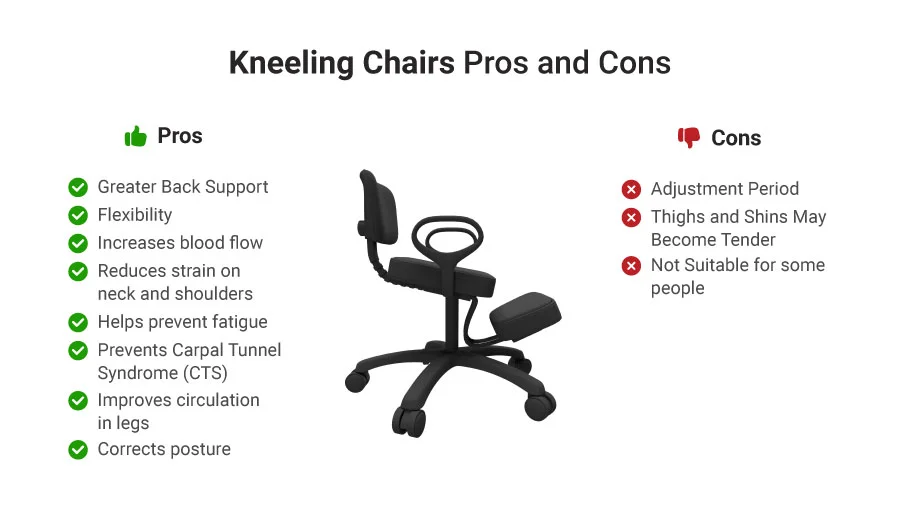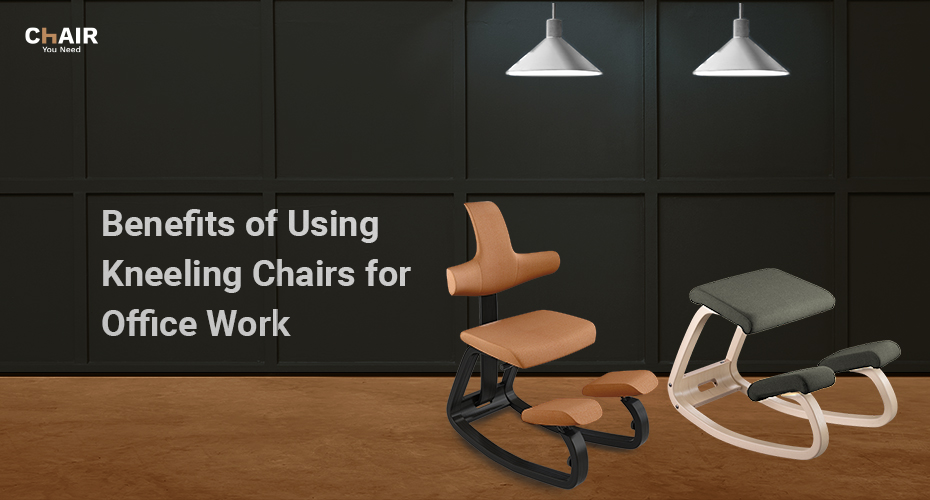I took the plunge and bought myself a kneeling chair for my home office. I had been seeing them in ads for a while, but wasn’t sure about it until I saw one in person at a friend’s office. My experience with mine over the past few weeks has convinced me that this is not merely a strange fad. It is surprisingly comfortable!
I figured that since I’m sitting at my desk all day anyway, I might as well be in something a little more comfortable than my regular office chair. Now that I’ve had the chance to use a kneeling chair with back support, here are some of the things i wanted to share:
What Is A Kneeling Chair?
The first Kneeling Chair was invented in Norway by Hans Christian Mengshoel in the 1970s. A specialized chair should encourage good posture by putting your body in an upright “open angle” position instead of keeping it closed by leaning over a desk or sitting in a traditional chair.
The feel of kneeling chairs is similar to bending your knees at 90 degrees and resting your thighs on a padded cushion while sitting on your thighs. My lumbar spine (lower back) is able to maintain its natural curve when my pelvis tilted forward. This helps me to to improve my posture by stretching it less.
Kneeling chairs tend to be simple in design, but they are a little difficult to use at first.
How To Sit In a Kneeling Chair?
What’s the correct way to sit in a kneeling chair? Well, it’s not that hard. But it does take some getting used to. Here’s what I learned:
- Your back should be straight and your hands should be on your lap as you sit down.
- Ensure that your feet are flat on the floor, while your knees are resting on the knee pads.
- Push yourself up from the chair with your toes so you’re standing up and leaning forward – like you’re about to walk away from it.
- To catch yourself as you lean forward, put your hands under your legs. The idea is to catch yourself when you reach the limit of what you can comfortably lean forward – without tipping over!
- Ideally, your feet and legs should be flat on the floor (or very close to flat).
- It should feel as though all three of your points of contact are supporting you. Try rocking backwards until all of them are touching again.
Are Ergonomic Kneeling Chairs Good For You?
My posture and habits with regard to sitting at my desk have always been horrible. Since my feet get cold easily, I slouch, lean on my arms or desk, and sometimes cross my legs. The three of these exert extra strain on my body and can result in pain if done for prolonged periods of time.
The benefits my ergonomic kneeling chair has brought have undoubtedly made a huge impact on my health. When you sit in a kneeling chair, your quads and hamstrings are at a 90 degree angle, which means your weight is evenly distributed between your knees and the chair. I have found that in a traditional chair, it is the backside that is most likely to be under pressure.
If you are seated properly, you are not under any pressure. No pressure means no pain, which means you can sit comfortably for longer periods of time than you would be able to with a normal chair.
Kneeling Chairs Pros and Cons
Being a computer geek, I spend hours in front of a computer every day. I’ve used office chairs, desk chairs, ball chairs and anything else that I could sit on for hours at a time. Some have worked better than others, but nothing has come close to the comfort of my kneeling chair.
Even though knee chairs are not everyone’s cup of tea (and they do look funny), they offer quite a few advantages over standard office chairs.

Pros:
- Greater Back Support:
Kneeling chairs support the back and encourage a good posture, especially if they come with a backrest. As you sit upright, you prevent compression of the discs in your lower back, which reduces strain on your spinal cord.
- Flexibility:
Kneeling chairs that help with posture, let you easily switch between sitting and kneeling positions. This keeps your muscles from becoming passive in one position throughout the day. The first thing I noticed was that it felt natural to sit on it. The seat is wide enough to support your legs comfortably, but narrow enough that you can still tilt your body forward naturally. As soon as I sat down, my back straightened up almost automatically.
- Increases blood flow
Kneeling chairs help you maintain proper spine alignment and support your back muscles by allowing you to sit upright rather than slouching. This will aid in the improvement of posture and also improve the circulation of blood to the brain and other parts of the body.
- Reduces lower back pain
The cushions on these kneeling chairs are designed to disperse weight evenly from the hips to the knees and shins, alleviating pressure on the lower back. A good quality kneeling chair should have a thickly padded seat cushion to provide proper support for your thighs. The seat cushion should be wide enough so that you can sit on it with your knees slightly bent and comfortably apart. A tall person will need a wider seat cushion than someone who is of average height.
- Reduces strain on neck and shoulders
In addition to making it easier to get into and out of your chair, the chairs also make it easier for your back. This is because they are built to fit your body rather than forcing you to sit in a certain way. You don’t have to worry about not being able to get out of the chair with ease because it will be easy for you
- Helps prevent fatigue
A feeling of fatigue occurs when you sit in one position for an extended period of time without moving. Kneeling chairs allow you to change positions even if you sit there for hours. Your spine will be completely straight when you move your arms side to side and adjust your position. This prevents fatigue from occurring after sitting for a long time.
- Prevents Carpal Tunnel Syndrome (CTS)
Numbness, tingling, and pain in the hand are symptoms of CTS, a medical condition that results from excessive pressure on the median nerve. The median nerve originates from the forearm and runs all the way to the hand. Carpal tunnel syndrome occurs when pressure is applied to this nerve, leading to tingling and numbness in your fingers.
- Improves circulation in legs
You will notice an improvement in circulation in your legs. By sitting with more weight on your legs than in a traditional chair, blood flow is enhanced since there is less pressure on your legs’ veins.
- Corrects posture
It is difficult to maintain good posture when you have many different health problems, such as back pain and neck pain. Sitting in chairs all day long results in bad posture because people’s spines become twisted by the way they sit. When you sit on a kneeling chair, your spine is straight, so your posture won’t be affected by it at all.
Cons:
Kneeling chairs may be beneficial for some users, but they do have some disadvantages.
- Adjustment Period
Getting used to a kneeling chair can take a while, which can make it difficult to focus on work during the initial adjustment period. You will need to experiment with different knee heights and angles in order to find a comfortable position. It is best to visit a showroom and test out different models before purchasing one.
- Thighs and Shins May Become Tender
If you aren’t used to kneeling chairs, they can lead to discomfort in your thighs and shins. Due to the angle at which your legs are bent when sitting in one of these chairs, you might experience some soreness in those areas. Eventually, your body will adjust to the position.
- Not Suitable for some people
One of the disadvantages of kneeling chairs is the risk of increased muscle fatigue. Kneeling chairs might not always be more comfortable than regular office chairs, plus they may not be suitable for people suffering from certain types of back pain. The resulting posture while using a kneeling chair can also place stress on the shoulders and neck.
Kneeling Chair Vs Ball Chair
Having spent much of my working life sitting at a desk, I have often wondered which chair is better for my posture and health – a ball or a kneeling chair? Based on my research, I have reached the following conclusions:
A kneeling chair is better for your posture because it forces you to sit up straight. A ball chair, on the other hand, allows you to slouch and can actually worsen your posture over time.
Kneeling chairs are also better for your back because they distribute your body weight more evenly. Ball chairs, on the other hand, can cause back pain because they put all of your body weight on your tailbone.
Another advantage of kneeling chairs is that they are less likely to cause you to fidget. Ball chairs, on the other hand, often encourage fidgeting because they are unstable. This can lead to reduced productivity and concentration.
So, if you are looking for a chair that will help you improve your posture and reduce your risk of back pain, a kneeling chair is the way to go. However, if you are looking for a chair that is more comfortable and allows you to fidget, a ball chair may be a better option.
Are Kneeling Chairs Bad For Your Knees
Kneeling chairs are designed to allow the user to sit in a position that takes the weight off their knees and legs. However, kneeling chair knee pain is a topic of controversy.
There are a few different arguments that people make when they say that kneeling chairs are bad for your knees.
The first is that when you sit in a kneeling chair, your knees are in an unnatural position. This can lead to joint pain and other problems over time.
Another argument is that when you use a kneeling chair, your body weight is not evenly distributed. This can also lead to joint pain and other problems.
Finally, some people argue that kneeling chairs can actually cause your knees to buckle. This is because when you sit in a kneeling chair, your knees are not in line with your hips. This can cause your knees to collapse, which can lead to serious injury.
So, are kneeling chairs bad for your knees? There is no definitive answer. Some people swear by them, while others say that they are bad for your health.
Are Kneeling Chairs Good For Your Back
According to Dr. Stuart Warden, an orthopedic surgeon at Indiana University Health, when you sit in a normal chair, your knees are usually lower than your hips. “It’s bad for your back if you sit that way for an extended period of time.”
That’s because sitting puts a lot of pressure on the lower back, he says. Good posture can relieve pressure and pain for those with lower back problems or sciatica.
Kneeling chairs put users into a more upright position — about 110 degrees — which creates less stress on the spine.
Final Words:
Kneeling chairs force your body to remain relatively upright while sitting, which makes it easier to keep your shoulders back and chest forward to maintain good posture. In some cases, the changes in posture can also change the way you move your arms and hands when working at a keyboard or doing other tasks, which further improves ergonomics.

